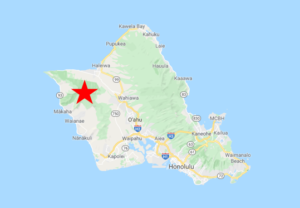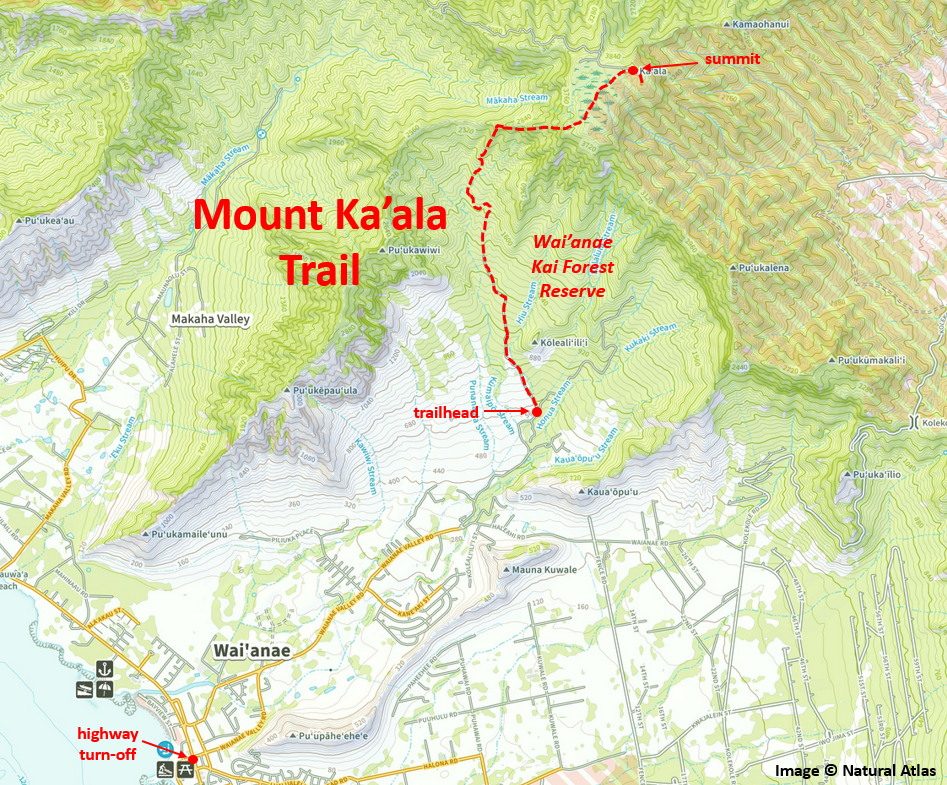Mount Ka’ala, Oahu, Hawaii

Western Oahu receives little attention from tourists, and public access to several potentially interesting areas is restricted. One exception is the trail up Wai’anae Valley to the highest point on the island, Mount Ka’ala, which is open to visitors who are inclined to strenuous hikes. The trail offers a good chance of finding Oahu Amakihi and Apapane, as well as some introduced species that are uncommon or absent from eastern Oahu: Erckel’s Francolin, Kalij Pheasant, and Indian Peafowl. At least until recently, and perhaps still, the valley has also harbored a few pairs of Oahu Elepaio.
Orientation
Directions
Mount Ka’ala is in the northcentral Wai’anae Range of western Oahu, accessed via a trail that begins in the Wai’anae Valley, above the village of Wai’anae, about an hour’s drive (40 miles) west of Honolulu, or 50 minutes (32 miles), from Hawaii’s largest airport, Daniel K. Inouye International.
To reach the trailhead from the airport, take the main freeway, H1, north (away from Honolulu) and remain on it as it winds west around Pearl Harbor. Shortly after passing Kapolei, the H1 freeway narrows and joins Highway 93, then bends north along the western coast of Oahu.
About ten miles farther on Highway 93, just past the center of Wai’anae (village), turn right onto Wai’anae Valley Road. Remain on this road for 3.6 miles to its end, where the trail up into the Wai’anae Kai Forest Reserve begins.
Birdfinding
The trail up the Wai’anae Valley to the top of Mount Ka’ala is physically demanding, 3.5 miles each way, with an elevation gain of approximately 2,700 feet. The hike requires some scrambling or bouldering, with ropes permanently installed—these are especially important for the descent. It is suitable only for fit, adventurous hikers.
Birds that are commonly seen along the trail include both of the island’s remaining honeycreepers, Oahu Amakihi and Apapane (which is more consistent here than in the Ko’olau Range above Honolulu). The trail passes through habitat that was formerly occupied by Oahu Elepaio, which has not been reported in recent years, as its range has contracted. At least into the 2010s and possibly beyond, a small elepaio population persisted nearby—mostly on the access-restricted eastern side of Mount Ka’ala—so it could potentially return, but it cannot be expected.

Male Oahu Amakihi. © Nick Kalodimos

Most of the same introduced forest birds that occur above Honolulu also occur at Mount Ka’ala, including White-rumped Shama, Red-vented and Red-whiskered Bulbuls, Japanese Bush-Warbler, Warbling White-eye, and Red-billed Leiothrix. An additional species that has become rare in eastern Oahu but may somewhat more likely in the west is the Chinese Hwamei.
Certain gamebirds occur at Mount Ka’ala that generally do not occur above Honolulu. Erckel’s Francolin is locally common, and there are small, tenuously established introduced populations of Kalij Pheasant and Indian Peafowl, both of which have been found breeding. The presence of the pheasant is mysterious, as the only population known to be established outside of Asia is on the Big Island. As no sightings appear to have been reported between Oahu and the Big Island, and pheasants are not widely noted for crossing expanses of open ocean, the few found on Oahu in recent years presumably originated from a separate introduction, and their relative proximity to the Big Island is coincidental.

Introduced Kalij Pheasants have apparently bred in the Ka’ala area and may be in the process of becoming established. © Ramesh Shenai
Services
Accommodations
There are two large resort hotels at Ko Olina, about eight miles south of Wai’anae. They are about equally expensive:
Aulani, a Disney Resort & Spa, Ko Olina, 1-866-443-4763
Four Seasons Resort Oahu at Ko Olina, 1-808-679-0079
Notes
Hazards & Hassles
Western Oahu has a long-standing reputation for car break-ins. Any area that is tucked away out of sight or where tourists often park has an elevated risk of this kind of opportunistic property crime.